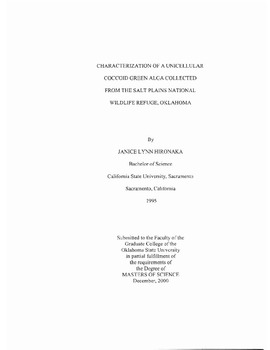| dc.description.abstract | An unusual, small (2 ~m diameter), coccoid, unicellular, green alga was isolated from a hypersaline pond at the Salt Plains National Wildlife Refuge in Oklahoma, USA and given the designation 980625-4A. This alga shows remarkable ability to tolerate a wide range of salinities (0-140 g-C l NaCl) and temperatures (0-40 �C). Efforts to identify this alga were based upon measurements of cell size, ultrastructure, and modes of cell division using electron microscopy, HPLC analysis of pigments, and cell wall staining with ruthenium red. The alga exhibits a smooth outer cell wall with no evidence of outer or vestigial structures. Transmission electron micrographs revealed one cupshaped chloroplast, one mitochondrion, one nucleus with one nucleolus. Several oval starch grains are interspersed between stacks ofthylakoid membranes in the chloroplast. An accumulation body is associated with the mitochondrion. TEM micrographs show no evidence of pyrenoids. Cell division occurs by autosporulation. Only two autospores are produced from each mother cell. Ruthenium red minimally stains the cell wall of 980625-4A, but significantly stained three Chlorella species. Pigments present are chlorophylls a and b, and major carotenoids are lutein, p-carotene, violaxanthin, neoxanthin, and vaucheriaxanthin ester. Pigment profiles exhibited greater similarity to pigments from Nannochloris sp. UTEX 2378 than other examined algae. These findings suggest 980625-4A is closely related to the genus Nannochloris. This is supported by recent 18S rDNA sequencing. Specific growth rates were measured at 25 and 40�C in AS100 media with salinities ranging from 0-120 g-L-1 NaCl. Growth rates showed statistically significant relationships to salinity, temperature, and combined effects of salinity and temperature. Growth rates at 25�C showed minor changes over the range of salinities. Growth rates were lower at 40 �c for all salinities, and cells showed no growth at 40�C and 0 g-L-1 NaCl. Ultrastructural distortions were observed in cells grown at 40 �c at all salinities. Osmolytes identified by HPLC-mass spectrometry include proline, glycerol, glucose, and glucosylglycerol. A comparison of cells grown at 0 and 40 g_L-1 NaCI showed a 1329 % or I3-fold increase in proline concentrations. Elevated salinity appears to protect 980625-4A from thermal stress if sufficient energy is available to sustain osmolyte production. | |
